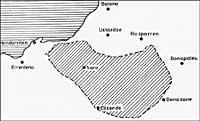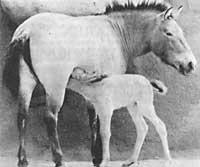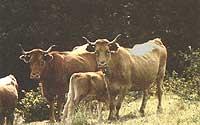Pottoka: Slender, free, ancient
1986/08/01 Aizpuru, Maria Luisa - Elhuyar Fundazioa | Yaniz Aramendia, Santiago Iturria: Elhuyar aldizkaria
A little history
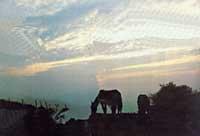
The word pottoka, which serves to designate any animal in Basque, began to be used to designate small horses and has finally been tied to this special breed.
Drawings and images of Euskal Herria (Ekain, Etxeberri, Santimamiñe...) Its main theme is the horse head, the favorite prey of the hunters of the Magdal era. In many of the drawings made on the bone also appears pottoka. These data make us think that the pottoka has lived in the mountains of Euskal Herria since the Paleolithic. Therefore, they would witness those prehistoric horses.
The origin of pottoka, according to some, is found in the Solutre period (Pleistocene). Others, however, say it is a pony brought from Europe in the Bronze Age or an autochthonous race that has lasted to date.
Whatever its origin, and with an unknown evolution, but using special biotopes that have helped it endure, this race of special zootechnical characters has come to this day. At this time, however, he is suffering an important phenomenon of hybridization, almost until the loss of racial purity.
Race similar to that of Pottoka, known as "asturians". They are small horses that live free and have suffered hybridizations and confusions. This breed needs protective measures to maintain itself.
In southern France there were also other pony races: the barthais race (disappeared at the end of the war) and the landetarra (disappeared as a pure race in 1946).
Population and distribution
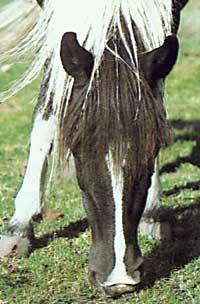
Considering the extent of the usual habitat of the pottoka, one of the characteristics of the population is its abundance. In Iparralde there were 3,500 purebred horses in 1970. In Hego Euskal Herria, 2000. The latter, however, have suffered greater hybridization.
Before the amount was higher. However, the commercialization, the decrease in the geographical area usually used by horses and the greater occupation of lands in the lower mountains are causing a decrease in the population of pottokas. It must be said, however, that race is gaining in quality thanks to the protective measures adopted.
Most of Pottoka lives in the provinces of Lapurdi, Baja Navarra and Baja Navarra, in this esophonous area located along the border. The limits of this territory are, to the west, the Atlantic Sea, to the North, San Juan de Luz, Ezpeleta, Hazparne, Iholdi and Donibane Garazi, and to the South, Bera, Etxalar and Elizondo de Navarra.
In the mountains of Bizkaia, Gipuzkoa and Araba you can also find very hybrid varieties of pottoka.
Wild horse
Pottoka is alive and fast, elegant. It is a clear step with a strong character. It is very sweet, but at the same time fearful. Free life in nature makes the defensive and lasting instinct very developed in the pottokas.
It is a wild pony horse, with a height between 1.15 and 1.47 m. Weight between 300 and 350 kg. The head is a symbol of its vitality and solidity, with classical proportions and practically equal to the type of horse of Solutre: robust, straight profile, somewhat concave to the sight and with short and upright ears. It has large bluish grey eyes, which reveal vitality, appearing on the edge of bristles that come down the forehead. Short neck, with long and numerous bristles. Open chest, wide and long back, slightly fallen saw and long hairy tail. Its legs are short and robust with small and hard helmets.
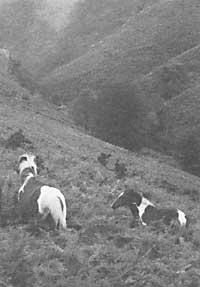
The fur is one of the most outstanding features of the pottoka. Young people are covered in autumn with a 10 cm thick slurry to protect themselves from the bad winter environment. In spring they change fur. They fall into pieces to immediately become short and bright hairs. Adults are also covered with long hairs in winter, but without becoming a juvenile coat. The thinner in winter, the longer the hair. This is the reaction of the organism that, through a longer hair, compensates for the lack of protection that involves the consumption of fats.
The color of the coat can be very different: brown-reddish, dark brown, black, brown-red, brown-reddish or pintxo of threesome. The most abundant color is brown-reddish, original color of the pottoka. Before almost all pottokas were brown-reddish or brown-dark. Currently, due to the growing demand of the pinttos, the color decreases. The pinto color is not the result of mutation, but of crossing horses. The pintos originally appeared in Bizkaia around 1850 and since then a small amount spread to Navarra and Lapurdi.
Habitat
The need to adapt to the environment that has lived for centuries has forced to adapt to the original being. Consequently, the pottoka has achieved a special constitution. Size, appearance and intelligence are determinant by inheritance, but the medium can alter these factors. The dispersion outside Euskal Herria has generated racial variability. Therefore, there has been a great difference between the horse born and raised on the mountain and that of the plain. The animal of the valley has a different morphology: higher height, wider chest, more horizontal saw and greater fertility. On the other hand, exporting to other places other than their origin, the race of the pottokas can degenerate in different ways.
As mentioned above, the original habitat of the pottoka is the mountains located in Lapurdi and on the border with Navarre. This area has an eroded relief, with rounded mountains that barely exceed 1,500 meters. The land of these mountains is of different geological nature. Despite this, they present a series of common characteristics such as soil acidity and lime and clay poverty. All this, together with the abundance of stones and rocks, makes them uncultivated lands.
The climate is oceanic, so there is a lot of humidity, temperate temperature and abundant rain and fog.
The vegetation is composed of beech and txillar ferns, some areas with oak forests and beech and conifer plantations.
The use of pastures is exclusive to sheep, cows and horses. The exploitation of these pastures is carried out through regularly renewed agreements. Nowadays these lands are changing little by little, so the pottoka has been leaving the mountain. This decrease in habitat has also intensified with coniferous plantations and the modification of the legal status of land ownership. All this has meant a change in the use of land traditionally used for pastures.
As the flocks have proliferated, several consortiums have banned grazing and the transit of horses, due to the bad conviction that the pottokas compete with the sheep. For he is not only the competitor of the sheep, but also the helper. Sheep only eat tips of grass, leaving the stems, while Pottoka feeds on hard herbs. These are milder in the following growths, making them ideal for sheep. In addition, the pottoka feeds on the buds of the tit cleaning the paths.
Pastures and free tours are necessary for the conservation of pottokas. It is an indispensable condition for the growth of pottokas in their original habitat.
Life and customs of Pottoka
The pottoka has always escaped man. For men it has been a hunting animal that is protected on the mountain. When the man went from being a hunter/collector to being a shepherd/producer, he began to be interested in this animal, so the life of these small horses has changed.
It is a social horse that lives in groups. The group normally consists of 10-30 females and the corresponding male. Their relationships are very special and reinforced in early spring and summer.
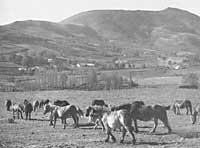
Each group lives in their territory. Through the generational renewal of customs, knowledge about topography, microclimate and vegetation passes from each other.
The width of the pastures may vary depending on the terrain relief and the quality of the grass.
The group is distributed on land of about two hectares. The group gathers when an unknown person surrounds or goes in search of water. They move slowly from one pasture to another, taking buds in a radius of about two square kilometers. If they find any danger or something frightening them, they flee to a known path.
These displacements are carried out according to the meteorology. Seeing where the pottokas are, you can see the weather. When they go down to the valley, the sign that the weather will get worse and if they are at the top of the mountain, the anticyclone arrives.
The displacements are controlled and guided by the male of the group. The rest follows the hierarchy within the group.
After August, the group is divided into 5 or 10 groups. The male does not integrate especially in any of these groups. This distribution is due to the poverty of herbs in times of drought and that the male, who has already covered it, does not pay much attention to the distribution. Groups remain in different places until autumn.
Relationships between group members
Friendships arise among mares due to the time they have in group. One is the driver of the team, at least to the extent others follow him. When comparing a new mare, it is crushed by others until a mare (usually the youngest) makes friendship.
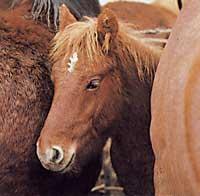
Pottokas have a very excellent communication system. Some are oral, such as friendly snoring and scary and angry. Most are gestures; with the movements of clays and ears, they express hatred, threat, curiosity, doubt and anxiety.
A matrix hierarchy is established in each group. This way each member of the group knows their level well. Driving mares do not have to dominate others by violence. Just move your ear, turn it around or shake your tail to scare your friends off the rampage. Although the steps are achieved through violence and struggle, horses never get to hurt seriously. The weakest leaves the struggle accepting its dependence. Old mares are recognized as team leaders. Groups or families form around them in late winter.
The fecundating male or calano leads the team, acting as head. If a male approaches a group that has no leaders, the female does not get the leadership in them until it covers it in ambient time.
From February to August the calano guides the team, maintaining a certain environment and taking care that no horse enters or can enter that place. It is usually separated from the females, usually in a high place, so that the smell of the females can be easily appreciated. To delimit its territory leaves excrements in several points and generally on the excrements of the female. When one of them is from a female glove, she goes in search of her lifting her tail and head before covering it and showing her teeth. These signs serve to show strangers their property and to warn that they cannot access this territory.
If someone wants to compete with his boss, he enters the team, faces him. Between them comes the typical rumble. They look and teach their teeth, ready to fight. They stand on the hind legs and intend to hit the other. When they fall to the ground, the front legs bite and, turning, throw the steles with the back legs.
The two horses move away from themselves and after a deep look they attack again. After twenty minutes, or perhaps before, the weakest is rejected. If the aggressor wins, she does not get the status of the winner until next season.

Young people constitute the lower hierarchy of the group. Females do not integrate into the group for two or three years, and until then they are very narcotic. Fry or foals, on the other hand, are immediately accepted and often accompanied by calano. However, when ambient time comes, it compares them, often with anger. In the second year they start looking for free mares and those who at the age of three have not managed to form a team, dare to break with the leaders of other teams to eliminate some female.
Reproductive cycles
Males are able to fertilize from two years, but up to four or five do not reach maturity. The females are covered at 3 years and with the four are raised.
The touring season occurs in spring-summer, with temperate temperatures and pasture reproduction. The pregnant female urinates more than normal and is usually very nervous. When the male feels his smell, he screams and comes to him. When they are together they launch powerful baffles. The mare gives a couple of boats to the male and this jumps scared and screams. If the female continues to object, the horse moves away, but in the following days an approximation is made until finally the female surrenders.
The coating is normally produced at dusk. After a short round, the horse is placed next to the mare, smelling the whole body. Suddenly it is compared so that the mare takes the proper posture. During pouring the bristle of the person is cooked candies. Then he lies very quiet on the ground.
In the days after mating, the female is happening until its reintegration into the group.
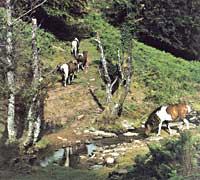
In the breeding season (eleven months later) the mare heads towards a lonely place to give birth. Immediately after delivery, she stands up breaking the umbilical cord and breaking the bag with her teeth. The child, after breathing, tries to stand up with the help of his mother and starts drinking milk.
Until a few days the mare and the puppy do not approach the group. When the newborn is able to strengthen and walk around his mother, they go to others. After joining the group, the child plays with other newborns.
At 6 or 7 months the dita is removed. By then, the puppy is usually strengthened and used to eating grass.
Pottokas: Past and future
Although pottoka has been a wild horse in the past, over time and despite living free, it has become a human heritage and used as a trade. It has become part of the livestock good. The group of horses is passed down from generation to generation among livestock owners. Horses have been sold annually at fairs and are still used in border smuggling trade.
Pottokas have also been used to transport hamlet products to the squares. However, since donkeys and controls can be used for further tasks, pottokas have been assigned a different function. They have been used mainly for the transport of border smuggling. XVI. From the 20th century they were also sold for use in the circus, but they have been used mainly for the transport of coal in the mines. Thanks to its low height and solidity it was very appropriate for this work. The horses were sold for a year and a half or two years and were shipped to Italy and Spain. Once the mining demand was over, they began selling for butchers and sausages.
It must be said, however, that in the last 10 years the situation of the pottokas has changed a lot. In 1970, the French administration of Haras officially recognized this breed with new uses of pottoka.
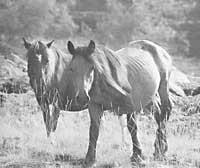
He is preparing for horseback riding and is creating a great hobby in the North Basque Country for pottokas excursions. The Basque Government, for its part, has been adopting for years a series of measures for the protection of pottokas.
The main points of sale of pottokas remain the local fairs, especially the main annual fairs held in Zumarraga and Heleta. Traffickers have jobs to bring the pottokas to the trucks, as these horses defend themselves harshly to get the freedom they have lost.
We hope that thanks to the protective measures adopted, pottokas will be maintained. Besides being a cheerful and pleasant horse, it is a symbol of Basque culture and an important witness of free life in the forest.

Gai honi buruzko eduki gehiago
Elhuyarrek garatutako teknologia




